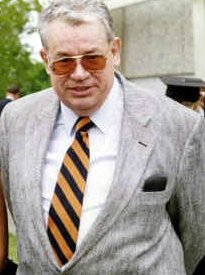Brinch Hansen
| Per Brinch Hansen | |
|---|---|

Per Brinch Hansen in 1999
|
|
| Born |
13 November 1938 Frederiksberg, Denmark |
| Died | 31 July 2007 (aged 68) Syracuse, New York |
| Fields | Computer science |
| Institutions | |
| Alma mater | Technical University of Denmark |
| Known for | |
| Influences | |
| Notable awards |
|
|
Website brinch-hansen |
|
Per Brinch Hansen (November 13, 1938 – July 31, 2007) was a Danish-American computer scientist known for his work in operating systems, concurrent programming and parallel and distributed computing.
Per Brinch Hansen was born in Frederiksberg, an enclave surrounded by Copenhagen, Denmark. His father, , worked as a civil engineer, becoming a leading expert in soil mechanics, and later accepting a professorship at Technical University of Denmark. His mother, Elsebeth Brinch Hansen (née Ring), was the daughter of Danish composer Oluf Ring and worked as a hairdresser before marrying.
Brinch Hansen attended St. Jørgens Gymnasium and then studied electrical engineering at Technical University of Denmark where he sought an area to pursue that "was still in its pioneering phase" on the belief that "If a subject was being taught, it was probably already too late to make fundamental contributions." After a seven-week student internship at IBM's Hursley Laboratory in England, he decided to dedicate his career to computers. Initially focused on computer construction, reading a book on IBM's Project Stretch that described computer organization from a programmer’s point of view refocused his interest toward becoming a computer architect.
After completing a master's degree in electronic engineering in 1963, Brinch Hansen landed a job at Regnecentralen, then a research institution under The Danish Academy of Technical Sciences, working in the compiler group, led by Peter Naur and Jørn Jensen. There, his first significant project was writing a parser for a COBOL compiler for the Siemens 3003 computer. Subsequently, he wrote a file system to be used during execution of the compiled COBOL programs, later observing “I now understand that it was really a small operating system, I had programmed. However, in the mid 1960s, the dividing line between language implementation and operating systems was still not clearly understood.”
...
Wikipedia
